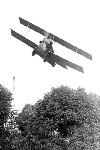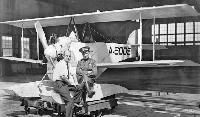Фотографии
-
This photo of an M.16 without skinning shows the inherent simplicity Tonini (who is in the cockpit) brought to the design. The constant-chord singlebay unstaggered wings had a span of 6m (19ft 8 1/4in) and an area of 11-3m2 (122ft2).
Самолёты на фотографии: Macchi M.16/M.20 - Италия - 1919
-
Регистрационный номер: A-6005 [2] One of the three Nieuport-Macchi M.16s acquired by the US Navy in the early 1920s undergoing water trials at Hampton Roads in Virginia. The M.16 was one of five types, of simple but rugged design, tested by the US Navy for use aboard its destroyers and submarines. In the event none was ever used for the intended role.
Самолёты на фотографии: Macchi M.16/M.20 - Италия - 1919
-
Регистрационный номер: I-BAGC Showing its bulged lower fuselage and an added dorsal fin to improve lateral stability, M. 16 l-BAGC (c/n 3090) is seen here at some point after its registration in October 1922.
Самолёты на фотографии: Macchi M.16/M.20 - Италия - 1919
-
An example of an original wheeled M.16, with a three-cylinder Anzani engine, in flight in Italy. Giulio Macchi founded the Societa Anonima Nieuport-Macchi in 1913, primarily to build Nieuport designs under licence, but from 1916 the company began producing its own highly successful series of aircraft designs.
Самолёты на фотографии: Macchi M.16/M.20 - Италия - 1919
-
The two gentlemen standing beside the red M-16 civil prototype at Malpensa emphasise the type’s diminutive size. Weighing less than 300kg (660lb) fully loaded, the M.16 had a top speed of 120km/h (75 m.p.h.).
Самолёты на фотографии: Macchi M.16/M.20 - Италия - 1919
-
Регистрационный номер: A-6005 [2] The three floatplane variants of the M.16 acquired by the US Navy were given the Bureau Numbers A-6005 to A-6007. According to original Macchi documents the type had an endurance of 3 1/2 hr, but the fitting of floats would have affected the performance of the tiny biplane, which stood less than 7ft (2-1m) tall, including the floats.
Самолёты на фотографии: Macchi M.16/M.20 - Италия - 1919
Статьи
- -
- D.Gordon - Spies in Cold War Skies
- G.Alegi - Macchi's Sky Scooter
- J.Franzi - To Hell and Back... /An eye for detail/
- J.Stroud - An Englishman in New York /The John Stroud Archive/
- K.Hayward - Trident. Britain's Fork in the Road?
- K.Honey - In the Land of Black Gold
- N.Mathisrud - The Other Stockholm Run
- N.Stroud - Willard Custer & the Channel Wing
- P.Davidson - Off the Beaten Track...
- P.Jarrett - Lost & Found
- R.Paver - Black on Wight
- T.Cooper - ...Blaaaam! Six dramatic minutes over Angola
- T.Oliver - Hands Across the Water?
- W.Robinson - The Reluctant Overnight Hero





